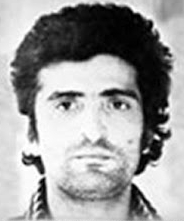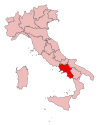The Camorra is an Italian Mafia-type criminal organization and criminal society originating in the region of Campania. It is one of the oldest and largest criminal organizations in Italy, dating to the 17th century. Unlike the pyramidal structure of the Sicilian Mafia, the Camorra's organizational structure is divided into individual groups also called "clans". Every capo or "boss" is the head of a clan, in which there may be tens or hundreds of affiliates, depending on the clan's power and structure. Consequently, as Camorra clans act independently, they are more prone to feuding among themselves. The Camorra's main businesses are drug trafficking, racketeering, counterfeiting, and money laundering. It is also not unusual for Camorra clans to infiltrate the politics of their respective areas.

Michele Zaza was a member of the Camorra criminal organisation who was also initiated in the Sicilian Mafia. He headed the Zaza clan in Naples. Zaza was known as ’O Pazzo due to his outspoken and implausible public statements. He was one of the first Camorristi to emerge as a powerful organiser of the cigarette contraband industry in the 1960s and 1970s.

Raffaele Cutolo was an Italian crime boss, leader of the Nuova Camorra Organizzata (NCO), an organisation he built to renew the Camorra. Cutolo had a variety of nicknames including 'o Vangelo, 'o Princepe, 'o Professore and 'o Monaco. Apart from 18 months on the run, Cutolo lived entirely in maximum-security prisons or psychiatric prisons after 1963. At the time of his death he was serving multiple life sentences for murder.
The Nuova Famiglia was an Italian Camorra confederation created in the 1970s and headed by the most powerful Camorra bosses of the time, Carmine Alfieri, the Nuvoletta brothers, Michele Zaza, Luigi Giuliano and Antonio Bardellino, to face Raffaele Cutolo's Nuova Camorra Organizzata, and affiliated with the Sicilian Mafia.

Vincenzo Casillo was an Italian Camorrista and the second in command of the Nuova Camorra Organizzata, a Camorra organization in Naples. His nickname was 'o Nirone.
The Nuova Camorra Organizzata was an Italian Camorra criminal organization founded in the late 1970s by a Neapolitan Camorrista, Raffaele Cutolo, in the region of Campania. It was also known by the initials NCO. The organization was established with the purpose of renewing the old rural Camorra, which dealt in contraband cigarettes and extortion schemes in the Neapolitan fruit market. To this end, Cutolo created a structured and hierarchical organization, in stark contrast to the traditional Camorra clans which are usually fragmented. The members of the NCO were often referred to by rival Camorristi and Italian law enforcement as "Cutoliani".
Luigi Giuliano is a former Italian Camorrista who was the boss of the powerful Giuliano clan based in the district of Forcella, Naples. He had multiple nicknames including "'o rre" and "Lovigino", which is an amalgamation of Luigi and love. In 2002, he decided to collaborate with Italian law enforcement and became a pentito, a co-operating witness against organised crime.

Antonio Bardellino was a powerful Neapolitan Camorrista and boss of the Casalesi clan, having a prominent role in the organized crime in the province of Caserta during the 1980s. He was one of the last of the old-style Camorra godfathers.
The Lo Russo clan was a Neapolitan Camorra clan operating on its territory within the city of Naples, concentrated specifically in the area of Miano, whose control extended throughout numerous neighborhoods in the north of the city for more than three decades. Since the fall of all the Lo Russo brothers, and the numerous arrests of most of its affiliates, the organization is considered overthrown.

The Nuvoletta clan was a powerful Neapolitan Camorra clan operating from the town of Marano di Napoli, situated on the northern outskirts of the city of Naples, southern Italy. The Nuvolettas belonged to a new style of Camorra, one that had the dimensions of a large corporation, and considered much more entrepreneurial. The clan was affiliated with several Sicilian Mafia families and was considered one of the most powerful Camorra clans between the 1970s and 1990s, however, since the death of its historical leaders and the large number of arrests and seizures made by the Italian police, the clan was succeeded by the Polverino and Orlando clans, both families with great degree of kinship with the Nuvoletta family.
The Mallardo clan is a Camorra clan operating from the town of Giugliano in Campania, north of the city of Naples. The Mallardo clan is also one of the clans that belongs to the Secondigliano Alliance, that is considered by the authorities as the most powerful Camorra group that is still active.
The Alfieri clan was a Neapolitan Camorra clan operating on the north-east of Naples, with its sphere of influence in the municipalities of Saviano and Nola.
Luigi Vollaro was a member of the Camorra, boss and founder of the Vollaro clan from Portici and San Sebastiano al Vesuvio.
The Mazzarella clan is a Campanian Camorra clan operating in the city of Naples. The clan is historically considered one of the most powerful groups of the Camorra.
The Giuliano clan was a powerful Neapolitan Camorra clan that had its base in the area of Forcella, in Naples. Its sphere of influence extended to all the centre of the city of Naples for over four decades.
The Rinaldi clan is a Camorra clan operating in the area of San Giovanni a Teduccio, in the eastern area of the city of Naples. Since 2019 the clan has formed an alliance with the Ponticelli's De Luca Bossa clan, and Barra's Aprea-Cuccaro clan, called by the media Rinaldi-De Luca Bossa-Aprea, which has emerged as the most powerful Camorra group in the eastern region of Naples.
The Aprea-Cuccaro clan is a Camorra clan operating in the area of Barra, in the city of Naples.
The Moccia clan is a powerful Camorra clan operating in the areas of Afragola, Casoria, Arzano, Caivano and surrounding areas. The clan is considered the oldest that is still active in the northeast area of the Metropolitan City of Naples. The organization has also a strong presence in the Lazio region. It's also defined as one of the most difficult clans to investigate precisely because of their ability to launder money.
The Cesarano clan is a Camorra clan from the town of Castellammare di Stabia, in the Metropolitan City of Naples.






